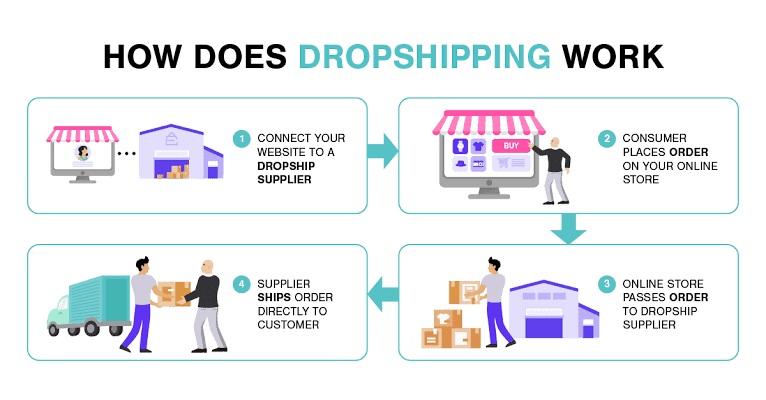Dropshipping business is a retail fulfillment method where the seller doesn’t hold inventory. Instead, when a product is sold, the seller purchases it from a third party and has it shipped directly to the customer. This eliminates the need for warehousing, inventory management, and upfront investment in stock.
Essentially, the drop shipper acts as a middleman, facilitating transactions between suppliers and customers without handling the products physically. In recent years, the landscape of e-commerce has been reshaped by the emergence of innovative business models, and dropshipping stands out as a prime example.
With its low barriers to entry and potential for lucrative returns, starting a dropshipping business has become an appealing venture for aspiring entrepreneurs worldwide. The first step is to choose your niche. Begin by identifying a niche market with high demand and low competition. Conduct thorough market research to understand consumer preferences, emerging trends, and potential profit margins within your chosen niche.
Once you’ve identified your niche, it’s time to find reliable suppliers. Partner with reputable suppliers who offer quality products, competitive pricing, and reliable shipping services. Platforms like AliExpress, Oberlo, and SaleHoo are popular choices for sourcing products from reliable suppliers.
With suppliers in place, the next step is to set up your online store. Create a professional and user-friendly e-commerce website or set up shop on established platforms like Shopify, WooCommerce, or Amazon. Customize your store to reflect your brand identity and optimize it for search engines to attract organic traffic.
Once your store is up and running, it’s essential to develop a comprehensive marketing strategy to drive traffic and generate sales. Utilize a mix of digital marketing channels such as social media, content marketing, email marketing, and influencer partnerships to reach your target audience effectively.
In addition to marketing your business, it’s crucial to provide exceptional customer service. Address inquiries promptly, handle returns and refunds efficiently, and strive to deliver a seamless shopping experience from start to finish. By prioritizing customer satisfaction, you can build trust and loyalty among your customer base, leading to repeat purchases and positive word-of-mouth referrals.
As you manage your dropshipping business, it’s essential to continuously monitor key metrics such as sales, conversion rates, and customer feedback. This will allow you to gauge the performance of your business and adapt your strategies accordingly. By staying agile and responsive to market dynamics, you can capitalize on opportunities and overcome challenges as they arise.
So, why is starting a dropshipping business so important? Firstly, dropshipping offers a low barrier to entry, allowing entrepreneurs to start an online store with minimal capital investment. This makes it accessible to individuals with limited resources who aspire to venture into e-commerce.
Additionally, dropshipping provides unparalleled flexibility and scalability, enabling entrepreneurs to operate their businesses from anywhere in the world and scale up as sales volume increases. Furthermore, dropshipping mitigates risk by eliminating the need to hold inventory.
This minimizes the risk associated with excess stock, slow-moving items, or changes in market demand, allowing entrepreneurs to test new products and enter new markets with minimal financial exposure. Moreover, dropshipping provides access to global markets, enabling entrepreneurs to tap into lucrative opportunities beyond geographical boundaries.
Lastly, by outsourcing inventory management and order fulfillment to third-party suppliers, dropshipping allows entrepreneurs to focus on their core competencies, such as marketing, customer service, and business development. This enhances efficiency and effectiveness in driving business growth.
Read Also: What You Need to Know About Auto Finance
How Does Dropshipping Business Work

The dropshipping business operates on a unique retail fulfillment model that has gained significant traction in recent years, reshaping the e-commerce landscape. At its core, dropshipping streamlines the traditional supply chain process by eliminating the need for inventory storage and management.
Instead, when a product is sold, the seller purchases it from a third-party supplier who then ships it directly to the customer. This innovative approach offers numerous benefits for both entrepreneurs and consumers, making it a compelling option for those looking to enter the world of online retail.
The process of how a dropshipping business works begins with the entrepreneur selecting a niche market and identifying products to sell. Unlike traditional retail models where merchants need to invest in inventory upfront, dropshipping allows entrepreneurs to start their businesses with minimal capital investment.
By partnering with suppliers who offer a wide range of products, entrepreneurs can curate a diverse product catalog tailored to their target audience’s preferences and interests. Once the entrepreneur has chosen their niche and selected products to sell, the next step is to set up an online store. This can be done through various e-commerce platforms such as Shopify, WooCommerce, or Amazon.
These platforms provide user-friendly interfaces and customizable templates, allowing entrepreneurs to create professional-looking stores that reflect their brand identity. From designing the layout and adding product listings to configuring payment gateways and shipping options, entrepreneurs have full control over their store’s appearance and functionality.
With the online store set up, entrepreneurs can begin marketing their products and attracting customers. Digital marketing channels such as social media, search engine optimization (SEO), email marketing, and influencer partnerships are commonly used to drive traffic to the store and generate sales. By leveraging these channels effectively, entrepreneurs can increase brand awareness, engage with their target audience, and ultimately, convert visitors into customers.
When a customer places an order on the dropshipping store, the entrepreneur forwards the order details to the supplier, including the customer’s shipping address and payment information. The supplier then fulfills the order by packaging the product and shipping it directly to the customer. Throughout this process, the entrepreneur acts as a middleman, facilitating transactions between the supplier and the customer without ever handling the physical products themselves.
One of the key advantages of dropshipping is its flexibility and scalability. Since entrepreneurs don’t need to hold inventory or manage fulfillment logistics, they can operate their businesses from anywhere in the world with an internet connection. This level of flexibility allows entrepreneurs to work remotely, travel, and manage their businesses on their own terms.
Moreover, dropshipping offers scalability, allowing entrepreneurs to expand their product offerings and reach new markets without the logistical challenges of managing inventory. As sales volume increases, entrepreneurs can easily scale up their businesses by adding new products, optimizing marketing strategies, and enhancing customer service capabilities.
Another benefit of dropshipping is its low risk compared to traditional retail models. Since entrepreneurs don’t need to invest in inventory upfront, they can test new products and enter new markets with minimal financial exposure. This risk mitigation strategy enables entrepreneurs to experiment, iterate, and adapt their businesses based on market demand and consumer feedback.
Furthermore, dropshipping provides access to a global network of suppliers and customers, allowing entrepreneurs to tap into lucrative opportunities beyond geographical boundaries. By partnering with suppliers from around the world, entrepreneurs can offer a wide range of products and cater to diverse consumer preferences, expanding their reach and driving business growth.
Read Also: The Benefits of Investing in Capital Goods
Advantages of Starting A Dropshipping Business

Starting a dropshipping business has emerged as a compelling opportunity for entrepreneurs seeking to enter the dynamic world of e-commerce. With its low barriers to entry, flexibility, and potential for profitability, dropshipping offers numerous advantages that make it an appealing venture for aspiring business owners.
1. Low Startup Costs: One of the most significant advantages of starting a dropshipping business is its low barrier to entry. Unlike traditional retail models that require a substantial upfront investment in inventory, storage space, and infrastructure, dropshipping allows entrepreneurs to launch their businesses with minimal capital shippers.
Since drop shippers don’t need to purchase inventory upfront or manage fulfillment logistics, they can allocate resources toward other critical aspects of their business, such as marketing, website development, and customer acquisition. This makes dropshipping accessible to individuals with limited financial resources who aspire to venture into entrepreneurship and e-commerce.
2. Scalability: Dropshipping offers unparalleled scalability, allowing entrepreneurs to expand their businesses rapidly as sales volume increases. Unlike traditional retail models that are constrained by inventory limitations and logistical challenges, dropshipping enables entrepreneurs to add new products, enter new markets, and scale their operations with ease.
Since dropshippers don’t need to worry about stocking inventory or managing fulfillment logistics, they can focus on growing their customer base, optimizing their marketing strategies, and enhancing their overall business operations. This scalability is particularly advantageous for entrepreneurs looking to build sustainable, long-term businesses that can help shippers solve market dynamics and consumer preferences.
3. Risk Mitigation: Another compelling reason to start a dropshipping business is its inherent risk mitigation benefits. By eliminating the need to hold inventory, dropshipping minimizes the financial risks associated with excess stock, slow-moving items, or changes in market demand.
This allows entrepreneurs to test new products, enter new markets, and experiment with different business strategies without incurring significant financial exposure. Additionally, dropshipping provides flexibility and agility, enabling entrepreneurs to adapt their businesses quickly in response to market trends, consumer preferences, and competitive pressures.
4. Global Reach: Dropshipping provides access to a global network of suppliers and customers, allowing entrepreneurs to tap into lucrative opportunities beyond geographical boundaries. Unlike traditional retail models that are limited by physical store locations and local markets, dropshipping enables entrepreneurs to reach customers worldwide.
By partnering with suppliers from different regions and offering a diverse range of products, dropshippers can cater to diverse consumer preferences, cultural nuances, and market trends. This global reach not only expands the potential customer base but also diversifies revenue streams and reduces dependence on any single market or region. As e-commerce continues to grow on a global scale, dropshipping offers entrepreneurs a strategic advantage in reaching and serving customers in markets around the world.
5. Alignment with Modern Consumer Preferences: Furthermore, dropshipping aligns with modern consumer preferences for convenience, variety, and personalized shopping experiences. With the rise of e-commerce and digital technology, consumers increasingly prefer to shop online for a wide range of products and services.
Dropshipping caters to these preferences by offering a seamless, hassle-free shopping experience, with fast shipping, diverse product offerings, and flexible payment options. Additionally, dropshipping allows entrepreneurs to leverage data analytics, customer insights, and marketing automation tools to personalize their offerings and enhance the overall shopping experience.
What to Avoid When Starting A Dropshipping Business

Starting a dropshipping business presents a wealth of opportunities for aspiring entrepreneurs, but it also comes with its fair share of challenges and pitfalls. To increase your chances of success in the competitive e-commerce landscape, it’s essential to be aware of common mistakes and pitfalls to avoid.
1. Choosing the Wrong Niche: One of the most critical decisions when starting a dropshipping business is selecting the right niche. Many beginners make the mistake of choosing a niche solely based on personal interests or trends without conducting thorough market research.
To avoid this, take the time to identify niches with high demand, low competition, and sustainable profit margins. Analyze market trends, consumer preferences, and competitor offerings to find a niche that aligns with your expertise and has long-term growth potential.
2. Partnering with Unreliable Suppliers: The success of your dropshipping business depends heavily on the reliability and performance of your suppliers. Unfortunately, some entrepreneurs make the mistake of partnering with unreliable or unresponsive suppliers, leading to issues such as delayed shipments, poor product quality, and customer dissatisfaction. To avoid this, thoroughly vet potential suppliers, and assess their reputation, reliability, and responsiveness. Establish clear communication channels and expectations upfront to ensure a mutually beneficial partnership.
3. Ignoring Customer Service: Exceptional customer service is crucial for building trust, loyalty, and repeat business in the dropshipping industry. However, some entrepreneurs make the mistake of neglecting customer service or providing subpar support to their customers.
To avoid this, prioritize customer satisfaction by addressing inquiries promptly, resolving issues efficiently, and maintaining open communication with your customers. Invest in tools and resources to streamline customer support processes and enhance the overall shopping experience.
4. Overlooking Legal Compliance: Legal compliance is another area where many dropshipping entrepreneurs falter. Ignoring legal requirements or failing to comply with regulations can result in costly fines, legal disputes, and damage to your brand reputation.
To avoid this, familiarize yourself with relevant laws and regulations governing e-commerce, including consumer protection, data privacy, and product safety standards. Ensure that your business operations, marketing practices, and product listings comply with applicable laws and regulations to protect yourself and your customers.
5. Relying Solely on Paid Advertising: While paid advertising can be an effective strategy for driving traffic and generating sales, relying solely on this approach can be risky and unsustainable. Some entrepreneurs make the mistake of overspending on paid advertising without diversifying their marketing efforts or optimizing their conversion rates.
To avoid this, adopt a balanced approach to marketing that includes a mix of paid advertising, content marketing, social media engagement, email marketing, and search engine optimization (SEO). Focus on building organic traffic, engaging with your audience, and providing value-added content to attract and retain customers over the long term.
6. Neglecting Brand Building: Building a strong brand is essential for standing out in the crowded dropshipping market and building long-term customer relationships. However, some entrepreneurs neglect brand building or fail to differentiate themselves from competitors.
To avoid this, invest in branding efforts that reflect your values, mission, and unique selling proposition. Develop a cohesive brand identity, including a memorable logo, consistent messaging, and visually appealing aesthetics. Focus on building trust, credibility, and loyalty among your target audience through authentic storytelling, customer testimonials, and social proof.
7. Underestimating Shipping Costs and Times: Shipping costs and delivery times are critical factors that can impact customer satisfaction and retention in dropshipping. Some entrepreneurs underestimate shipping costs or fail to communicate accurate delivery times to their customers, leading to dissatisfaction and negative reviews.
To avoid this, accurately calculate shipping costs, including taxes, duties, and other fees, and clearly communicate them to your customers at checkout. Provide transparent tracking information and realistic delivery estimates to manage customer expectations and minimize the risk of disputes.
8. Neglecting Market Trends and Consumer Preferences: The e-commerce landscape is constantly evolving, with new trends, technologies, and consumer preferences shaping the industry. Some entrepreneurs make the mistake of neglecting market trends or failing to adapt their strategies to changing consumer preferences.
To avoid this, stay informed about industry developments, monitor market trends, and analyze consumer behavior to identify emerging opportunities and threats. Stay agile and responsive to market dynamics by adjusting your product offerings, marketing strategies, and customer service practices to meet evolving consumer needs and preferences.
In conclusion, starting a dropshipping business offers tremendous opportunities for entrepreneurs to enter the e-commerce space and build successful ventures. However, it’s essential to be mindful of common mistakes and pitfalls that can derail your efforts and hinder your success.
By avoiding these pitfalls and implementing best practices in areas such as product selection, supplier relationships, customer service, marketing strategies, and legal compliance, you can increase your chances of building a profitable and sustainable dropshipping business in today’s competitive market landscape.
Read Also: The Ultimate Guide to a Calisthenics Workout






